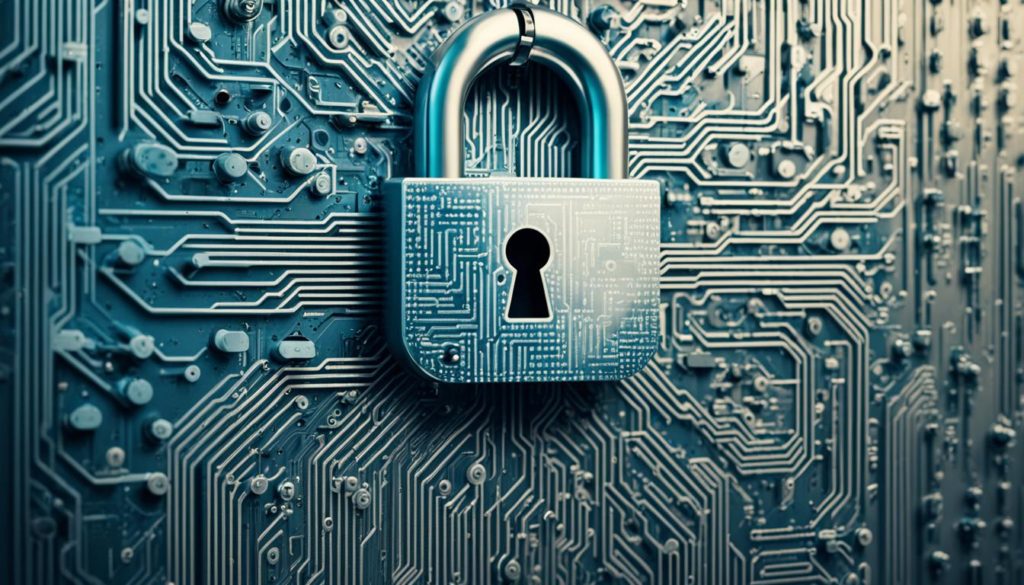
Did you know the average cost of a data breach is $3.86 million? This statistic comes from IBM’s 2020 Cost of a Data Breach Report. It also takes about 280 days to find and manage a breach. This highlights the need for strong cybersecurity for preventing data breaches.
Working from home has made data security even harder. It has increased the time for managing breaches. This adds roughly $137,000 to each incident’s cost. Since human error causes nearly half of these breaches, we need multiple strategies to protect our data.
Protecting company data requires several steps. These include teaching employees about security, monitoring work remotely, and using the latest security software. By understanding and reducing risks, a company can save money and its good name. This shows why it’s so important to have a full approach to protecting company data.
Taking extra steps is crucial for a strong defense. Encrypting data, setting user permissions, and regular cybersecurity audits help protect against threats. By actively securing our data, we protect our operations and prepare for future cyber threats.
Key Takeaways
- The average cost of a data breach is $3.86 million.
- It takes 280 days on average to contain a breach.
- Remote work increases both the cost and time to manage breaches.
- Human error accounts for 52% of data breaches.
- Robust cybersecurity measures, including employee training and data métodos, are essential for preventing breaches.
Understanding the Impact of Data Breaches
In today’s world, data breaches are a big challenge for companies everywhere. They lead to huge money losses and damage reputations. They also bring serious legal problems. Let’s look at the financial, reputational, and legal effects of data breaches.
Financial Consequences
The cost of data breaches hit an all-time high of USD 4.45 million in 2023. The Heartland Payment Systems breach in 2008 is a key example. It exposed 130 million credit card numbers, causing big losses.
Companies lose money from lost business, legal fees, and compensations. After a breach, 51% of companies say they’ll spend more on security. You can learn more in this report.
Damage to Reputation
The Facebook breach in 2019 hurt the company’s reputation badly. It exposed data of over 530 million users. This made many people lose trust in Facebook, affecting sales.
Target’s breach in 2013 impacted 70 million customers and damaged its brand. It shows the importance of cyber threat prevention to rebuild trust.
Legal Implications
Breaking data protection laws can lead to massive fines. For example, Meta faced a €1.2 billion fine in 2023 due to GDPR non-compliance.
The Alibaba breach in 2022 exposed data of a billion people. It showed how crucial it is to follow data protection laws to avoid legal costs.
To reduce these impacts, it’s vital to prevent cyber threats. As digital dependence grows, cybersecurity must be a top priority for all organizations. For more insights, check out this article.
Effective Cyber Threat Prevention Measures
The potential impacts of data breaches are too serious to ignore. Companies must take steps to reduce their risk. Regular security checks, new technologies, and strict control over data access are key. For more information on how to protect your organization, read this piece.
Common Sources of Data Breaches
Understanding how data breaches happen is key to protecting your organization. We need to know about threats from outside, inside, and lost gadgets to keep info safe.
External Threats
Businesses face risks from outside like phishing attacks and malware. Phishing tricks people into sharing private info on what looks like safe sites. These attacks are tricky because they play on human mistakes.
Malware threats are on the rise too. They can get past strong defenses as seen with Verizon and others. It shows we must always be on guard and ready to catch new threats.
Internal Vulnerabilities
Weak passwords and bad setups can cause big problems too. With 80% of breaches linked to weak passwords, improving password security is a must. We also have to watch out for unhappy workers who might leak important info.
| Type of Threat | Risk Factor |
|---|---|
| Phishing Attacks | Email and Web Links |
| Malware | Downloads and Attachments |
| Insider Threats | Disgruntled Employees |
| Misconfiguration | Improper Settings |
Too complex access settings can make way for hackers. It’s vital to keep systems simple and check them often for safety holes.
Lost or Stolen Devices
When gadgets with important info get lost or stolen, it’s a big risk. These physical losses remind us to protect devices well. Stolen laptops have let out major secrets before.
This shows us the danger of data theft and how crucial encryption and remote wipe tools are. With a solid plan, we can fight off these threats and keep our data safe.
Cybersecurity Measures for Data Protection
In today’s world, keeping our information safe is a must. We use a strategy with layers. It includes the latest encryption technologies, tough intrusion prevention systems, and strong multi-factor authentication (MFA) protocols. Using these tools helps us stay safe from cyber threats.
Encryption
Encryption is key in protecting our data. It turns data into code that only people with a key can read. This method is essential for keeping information safe, whether it’s being sent or stored. It helps make our cyber defenses stronger.
Firewalls and Intrusion Detection
Firewalls act as a gatekeeper, checking both incoming and outgoing traffic based on rules. Then, intrusion prevention systems watch for bad activities. Together, they make our cyber defenses even stronger.
Multi-Factor Authentication
Multi-factor authentication (MFA) makes it harder for bad actors to get in. It asks for more than one proof of identity, like a password and a fingerprint. MFA boosts our defense, matching up with the best security practices.
| Cybersecurity Measure | Description | Benefits |
|---|---|---|
| Encryption | Utilizes encryption technologies to protect data | Ensures data confidentiality and integrity |
| Firewalls | Filters network traffic based on security rules | Blocks unauthorized access |
| Intrusion Prevention Systems | Monitors and responds to suspicious activities | Detects and prevents breaches in real-time |
| Multi-Factor Authentication (MFA) | Requires multiple verification steps | Reduces risk of credential theft |
Implementing Data Security Best Practices
In the digital world, keeping data safe is a must. We must focus on strong passwords, training our team, and controlling access. These steps are vital for protecting against hacks and improving our defense.
Password Management
Robust password policies keep our data safe. Using strong, different passwords and tools to manage them helps stop unauthorized entry. Good password rules and quick actions after a breach can make a big difference. Phishing is costly, leading to losses of around USD 4.91 million per attack in 2022.
Employee Training
Teaching our employees about cybersecurity is crucial. Regularly updating them on how to stay safe online helps in spotting dangers. Fast reactions to hacks, ideally in less than 200 days, can save about $1.1 million.
Access Controls
Managing who gets access to what is key. Customizing permissions for each person helps protect sensitive info. Nearly 60% of hacks come from outside partners, so tight access control and checking regularly are essential.
By keeping an eye on strong passwords, educating our team, and controlling access, we build a strong shield. This helps keep our data secure from threats.
Preventing Data Breaches
To protect our organization from cyber threats, we must act ahead of time. It’s vital to regularly check our security and use advanced technology to spot possible threats. Let’s explore these ideas more.
Regular Security Audits
It’s crucial to regularly examine our security systems to assess risk and ensure we meet standards. These checks help us find and fix weaknesses. They keep our data safe and give us peace of mind.
Advanced Threat Detection
Advanced threat detection helps us prevent cyber attacks. Using AI and machine learning, it constantly looks for suspicious behavior. This smart technology keeps us safe from new and changing threats.
Here’s a comparison of regular security audits and advanced threat detection:
| Aspect | Regular Security Audits | Advanced Threat Detection |
|---|---|---|
| Purpose | Identify gaps, ensure compliance | Detect and mitigate threats proactively |
| Technique | Manual and automated reviews | AI and machine learning algorithms |
| Outcome | Enhanced security policies | Real-time threat intelligence |
| Frequency | Periodical | Continuous monitoring |
Strategies for Safeguarding Sensitive Information
Nowadays, keeping sensitive info safe is key for businesses. We use several layers of defense against new threats. Here are the main ways we protect sensitive data:
Data Encryption
Encrypting data is a must for protection. It changes data into a secret code to block unauthorized access. We encrypt data, whether it’s stored or being sent, to stop hackers. This keeps info safe, even if someone tries to steal it.
Network Segmentation
Network segmentation is like an internal guard for our IT systems. It splits a network into smaller parts to limit hacker entry points. This method keeps our network secure by isolating breaches, so they don’t spread.
Endpoint Security
With more people working remotely, securing devices is crucial. We use antivirus, update regularly, and monitor in real-time to protect devices. This strong protection means info stays safe, no matter where our team is working.
Responding to a Data Breach Incident
When a data breach happens, having a good plan for action is key. This plan helps us act fast. We must tell stakeholders and regulatory bodies quickly and clearly. Following rules like GDPR and CCPA helps us minimize legal risks. It shows we’re serious about protecting consumer data.
Incident Response Plan
Crafting a detailed incident response plan is vital for any group. This plan involves finding the breach, containing it fast, and getting rid of the threat. A well-thought-out plan means each step is recorded. It also means teams know what to do when there’s a data breach.
Communication Strategy
Talking effectively about a data breach is crucial. It’s important to have a clear process for telling people what happened. Keeping things transparent builds trust. We need to share correct details on what we’re doing to fix the breach.
Regulatory Compliance
Following rules like GDPR and CCPA during a data breach is a must. These laws have clear steps we need to take. By sticking to these rules, we lower the chance of legal problems. We also show we’re committed to keeping personal data safe.
Conclusion
Today, keeping our data safe is crucial. We need a strong promise to ourselves and smart, wide-ranging steps. By adding powerful defense methods and safe work ways, we make our cyber safety better.
We must start using the best data safety steps early to stop any security breaks.
Putting a clear plan for handling security issues is just as key. This makes sure we act fast and well if problems happen, keeping harm low. Keeping an eye on safety, learning more, and following rules build a solid security base. These steps help us stay strong against online dangers.
To wrap up, always getting better and adjusting is at the heart of our cyber safety plan. This approach helps us not just keep our own group safe but also builds a culture that values security. Our focus on being alert and resilient helps us keep going. It shields our precious data from harmful attacks.
FAQ
What are some key strategies for preventing data breaches?
To stop data breaches, use strong passwords and teach your employees well. Use remote monitoring, back up data, keep data use low, and secure your physical space. It’s key to handle data safely and have strong cybersecurity.
How do data breaches financially impact companies?
Data breaches cost a lot. IBM’s 2020 study found they cost .86 million on average and take 280 days to fix. By 2023, the cost rose to .45 million. Remote work can make these costs even higher.
What are the reputational consequences of a data breach?
A data breach can really hurt a company’s good name. It makes customers lose trust and lowers the brand’s value. Getting back customer trust is hard and expensive.
What legal implications can arise from a data breach?
The law can be tough on companies after a data breach. Rules like GDPR and CCPA can mean big fines. It’s vital to follow the law to avoid risks.
What are the common sources of data breaches?
Breaches mostly come from phishing, malware, and system weaknesses. Poor passwords and network issues matter a lot. Lost or stolen devices are a big risk too.
How can encryption help in data protection?
Encryption is key for keeping data safe. It protects data when it’s being sent and when it’s stored. This stops unauthorized people from getting to it.
What roles do firewalls and intrusion detection systems play in cybersecurity?
Firewalls keep your network safe by blocking outsiders. Intrusion detection spots suspicious activity. They both help fight off cyber threats.
Why is multi-factor authentication (MFA) important for data security?
MFA makes it tougher for attackers by using several checks for access. This helps keep your data safe, even if a password is stolen.
What are best practices for password management?
Use strong, unique passwords for all accounts. Change them often. And use password managers to keep and make safe passwords.
How can employee training enhance cybersecurity?
Teaching employees about security risks helps keep data safe. Regular training keeps everyone ready to protect against threats.
What access controls should be implemented for better data security?
Good access controls limit who can see sensitive data. They give people access based on their job. This lowers breach risks.
How do regular security audits contribute to data protection?
Security audits check if you meet standards and find any security gaps. They are key to keeping your cyber defenses strong.
What is advanced threat detection, and why is it important?
Advanced threat detection uses AI to quickly spot dangers. It checks in real time, making your response to threats faster.
Why is network segmentation important for data security?
Splitting a network into parts makes it safer. If an attacker gets in, they can’t easily reach everywhere. It keeps sensitive data more secure.
What is endpoint security, and how does it help in safeguarding data?
Endpoint security keeps devices like laptops safe from threats. With more people working remotely, it’s crucial for keeping data secure.
What should an effective incident response plan include?
A good incident plan tells you what to do right after a breach. It outlines roles, steps, and how to talk about the breach. This keeps the response smooth and quick.
How important is communication strategy in responding to a data breach?
Talking right about a breach is key. You need to tell stakeholders and the law quickly and clearly. This helps protect your reputation and meets legal needs.
Why is regulatory compliance crucial during a data breach incident?
Following laws like GDPR and CCPA after a breach is key to avoid trouble. It shows you take data protection seriously and keeps trust up.
Future App Studios is an award-winning software development & outsourcing company. Our team of experts is ready to craft the solution your company needs.










